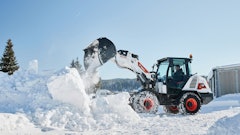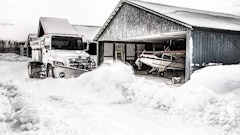
More than half of snow removal contractors enjoyed a sales increase last season, and nearly everyone expects to at least maintain their current sales volume for the next two years. It’s not going to be easy, though. Customers are expecting more for a lot less.
“The 2010-2011 season was another busy winter,” says Brian Akehurst of Akehurst Landscape Service in Joppa, MD. “We didn’t have the snowfall amounts we had the previous year during Snowmageddon, but we still had multiple events.” Akehurst services a variety of retail, office and industrial properties, in addition to a mix of homeowner associations, planned communities and private residences.
In the Chicago market, Grant & Power Landscaping says its sales were up slightly, although its number of contracts grew substantially. “Our biggest challenge is the economy—and what it’s doing to the commercial market,” says Scott Hutchings, partner and vice president of operations. “The market here has gotten smaller. There are a lot of new plowers getting into the business. Even though it’s not as bad as in landscape maintenance, there is pricing pressure.”
Challenging, but not insurmountable
“One of our biggest challenges has been maintaining our current account base while having a service platform that’s scalable and effective enough to acquire new accounts, regardless of their location or complexity,” says Laura McMurray, president and CEO of Wichita, KS-based Complete Landscaping Systems. This is not a new issue, McMurray adds, but current economic conditions have made it more daunting. “The focus on metrics such as cost savings, risk mitigation and quality has been driven to an all time high.”
Many commercial property managers are looking for better service at an even lower price. The challenge for contractors is finding ways to meet both of those demands while remaining profitable.
“We are all faced with a slow economy,” Akehurst reminds. “Many of our clients have vacant buildings or have had to renegotiate leases with their tenants. To create a balance, they are looking to cut cost wherever they can. It’s no secret that our costs have also increased, from fuel to insurance to equipment and materials. But our clients don’t want to pay more, period. If we don’t give them what they want, they will find someone else to do it—no matter how good your relationship is with them.”
Colorado contractor John Reffel was able to increase his snow portfolio by 40% last year. “Existing clients gave us additional properties,” he points out. “Some were accounts we were already doing snow removal for, others were customers we did landscape maintenance for. In one instance it was a matter of a property manager not being happy with the national firm he’d been using.” Reffel is the owner of JLS Landscape & Sprinkler in Sedalia.
How to adapt and overcome
Hutchings says Grant & Power has been able to maintain its better than 90% customer retention rate, but doing so has been a real challenge. “Some price concessions have definitely had to take place,” he relates.
Flexibility. Grant & Power has also taken measures to remain flexible with contract structuring. Hutchings estimates that 25% of their contracts are seasonally fixed while another 25% are fixed on a monthly basis. Quite a few are hybrids. “We like to customize services for our clients,” says Jan-Gerrit Bouwman, partner and sales manager.
Communication has been another focus. “The biggest thing we hear when we land a new account is that the previous contractor didn’t communicate well,” Hutchings points out. “We communicate with the customer before, during and after a snow event.” Clients like to use email, but Grant & Power account managers also phone customers directly with news and updates. “Then we email a summary of what we did after each snow event,” Hutchings adds.
JLS Landscape also takes a lot of pride in its communication efforts. As soon as a storm is forecasted, clients (property managers) receive an email. “I’ll usually include the weather forecast in the body of that email,” Reffel explains. As the storm closes in, perhaps 24 hours away, clients get another email. This one is much more elaborate. “We identify when the storm is expected to peak—and what our plan of attack is going to be,” Reffel says. Once the storm hits, clients receive email updates every 12 hours or so. “It’s amazing what this has done for us,” Reffel relates. “My phone used to ring off the hook. Now our customers rarely call; they simply don’t have to.”
The right customers. Working for clients who value this type of communication—and quality service in general—is the other half of the equation. “We focus on the ‘zero tolerance’ commercial clients who want you there when there’s just a dusting, or even before it snows,” Hutchings says. “Our clients include medical centers, banks, churches and industrial offices. We stay away from gas stations and restaurants. Our focus is high-need clients who want high-quality work.”
Work processes. Maintaining a high level of service as pricing pressures continue to mount has been a challenge for contractors. “Our focus has been on capturing efficiencies and cost savings,” McMurray says. Her company is doing that, in part, by identifying a variety of best practices from each of its five branches, and implementing those best practices in each branch.
This process is known as creating standard work. Reffel learned a lot about this by completing the Working Smarter Training Challenge (greenindustrypros.com/working-smarter). He and his staff brainstormed together to identify ways to improve work processes, reduce waste and lower operating costs.
Reffel’s company now has standard work, in the way of checklists and written procedures, for inspecting plows and other equipment, cleaning trucks, and making sure each truck has everything it needs before heading off to a property. They even have written processes for each property they service.
“The typical property has a two-page document,” Reffel explains. “The first page is a color-coded map; red denotes an area for snow storage, yellow denotes sidewalks, green denotes secondary sidewalks, etc. We also highlight areas where we absolutely cannot pile snow. The second page contains basic safety information, reminders about not pushing snow out into the street, and information specific to that site, such as ‘no snow around north dock.’”
Reffel shares this information on standard work with his sub-contractors, too. “The biggest thing today is providing consistent work,” Reffel says. “That’s why we pull all of our subs in at the beginning of the season and train them on our standard work. Most of the plowing we do is on an hourly basis. If we can find ways to cut time without sacrificing quality, the better off we’ll be.”
Equipment. Like Reffel and McMurray, Akehurst is also rethinking processes and restructuring systems to allow crews to do more with less while still providing superior service. “We’re also researching some of the new technologies and equipment that are available to see how they would fit into our operation,” he adds.
Same goes for Reffel. “We’re using box plows a lot more on larger sites,” he says. “They are fast and clean. We use a 16-footer on a 3-yard loader, but also use smaller plows on skid steers. Generally we park those big loaders on site, unless we don’t get snow for more than a week and have a landscape project to do.”
Grant & Power has been making more use of their liquid sprayers in both de-icing and anti-icing operations. “Two of our plow trucks also have liquid sprayers mounted in the bed,” Hutchings says. “Our crews also have push sprayers for sidewalks.” Bouwman says Calcium Chloride is their agent of choice. It’s more expensive, but works down to extremely frigid temperatures of -25°F.
Reffel began seeing a surge in demand for Magnesium Chloride a couple of years ago, but that quickly dissipated when the economy tightened up. “Property managers don’t like the extra expense … they’d just as soon see Ice Slicer (granular ice melt),” he says. “I also asked my clients how much they valued ‘green’ practices. They said, ‘not too much if it’s going to cost more’.”
Today it’s all about giving your clients what they want. In many cases, it’s also about giving it to them for what they’re willing to pay.
EDITOR’S NOTE: Graph data based on June 2011 survey of SnowPRO subscribers.


























